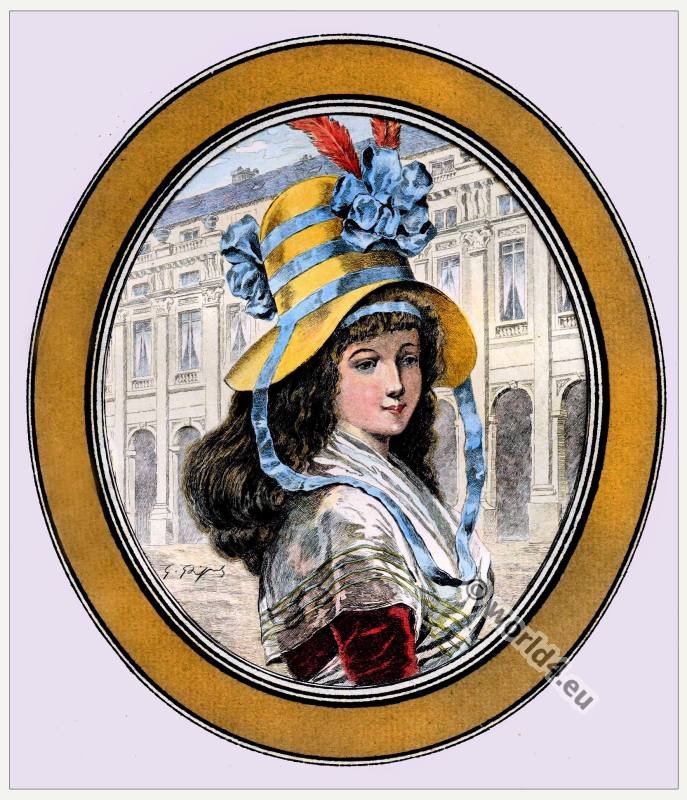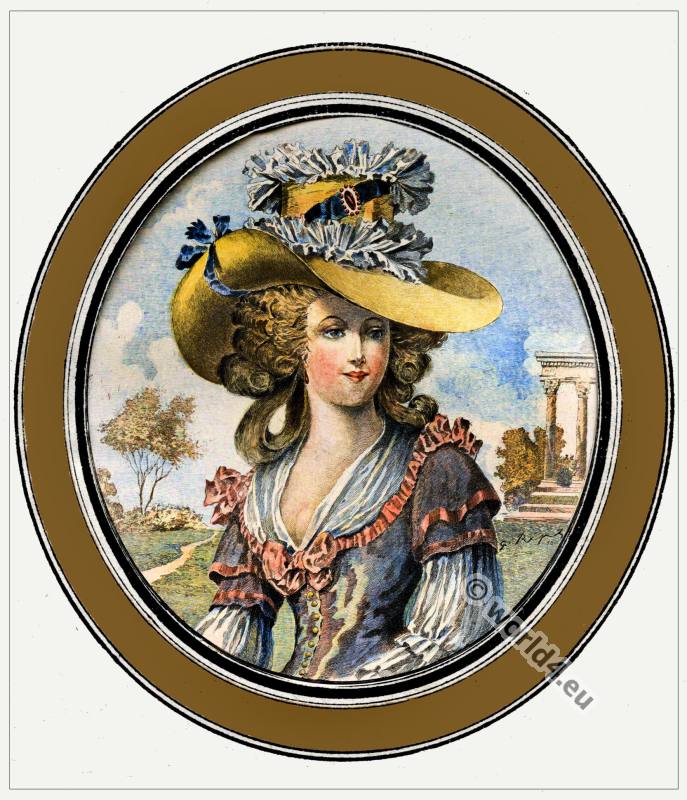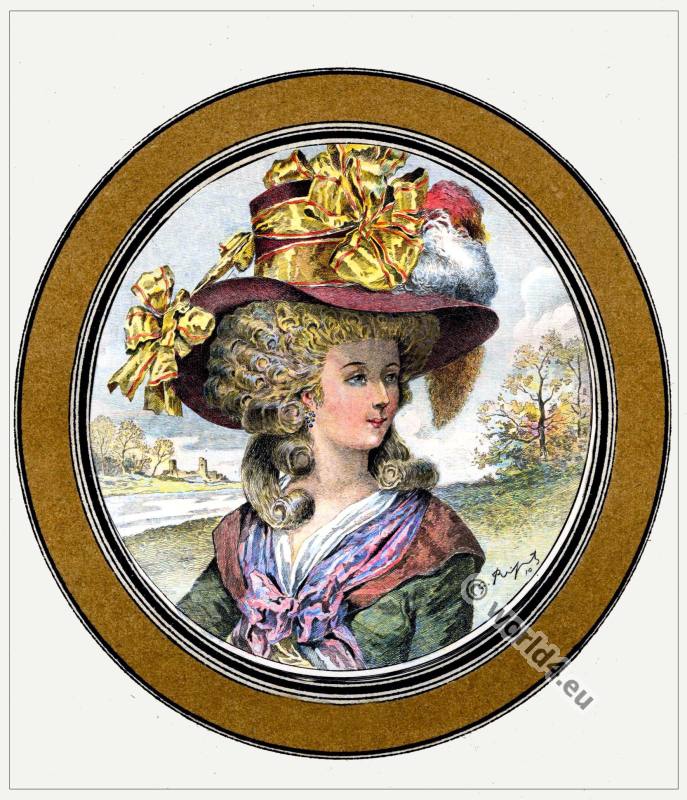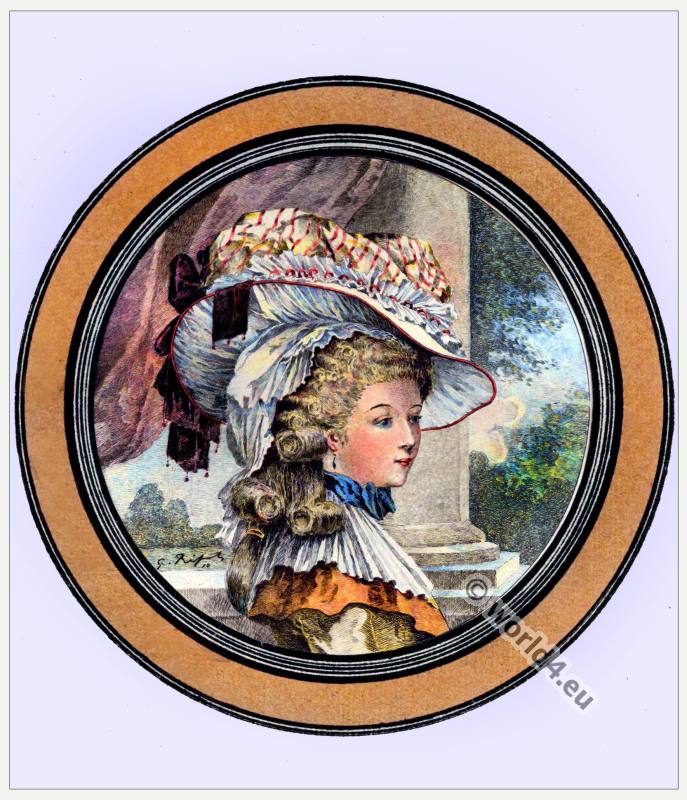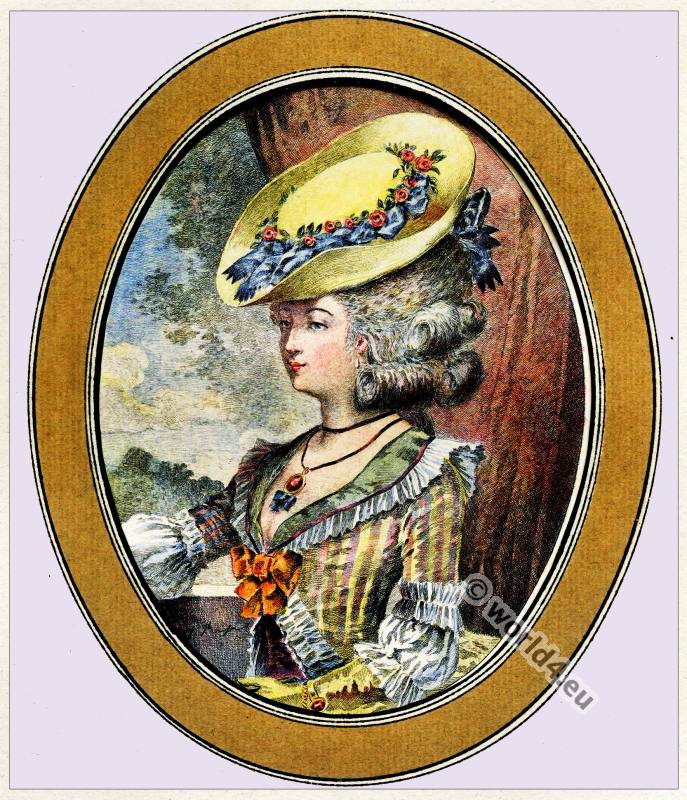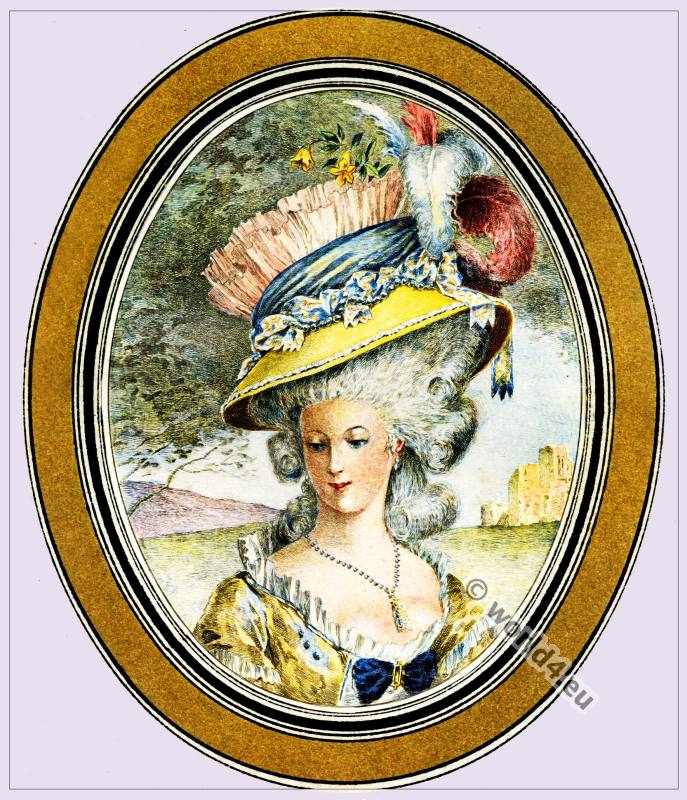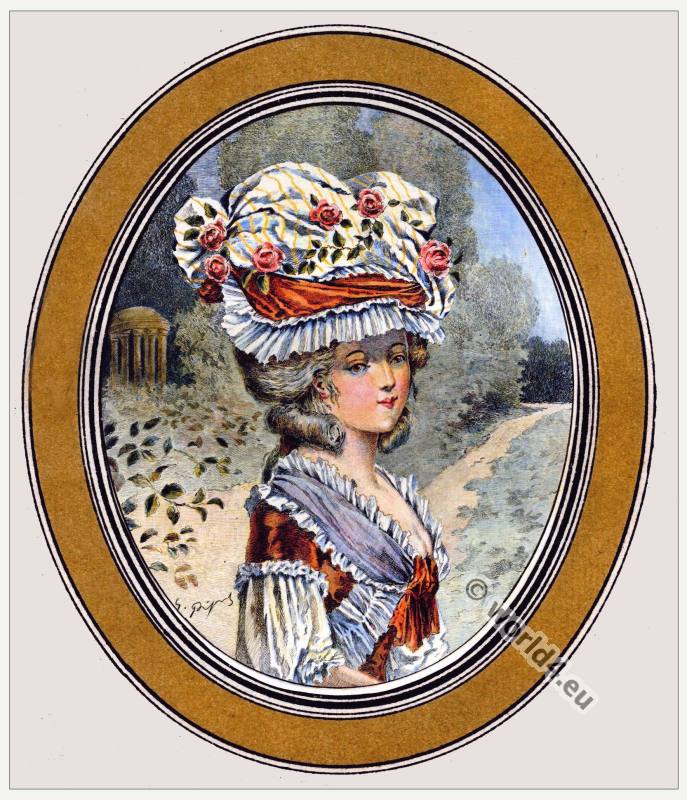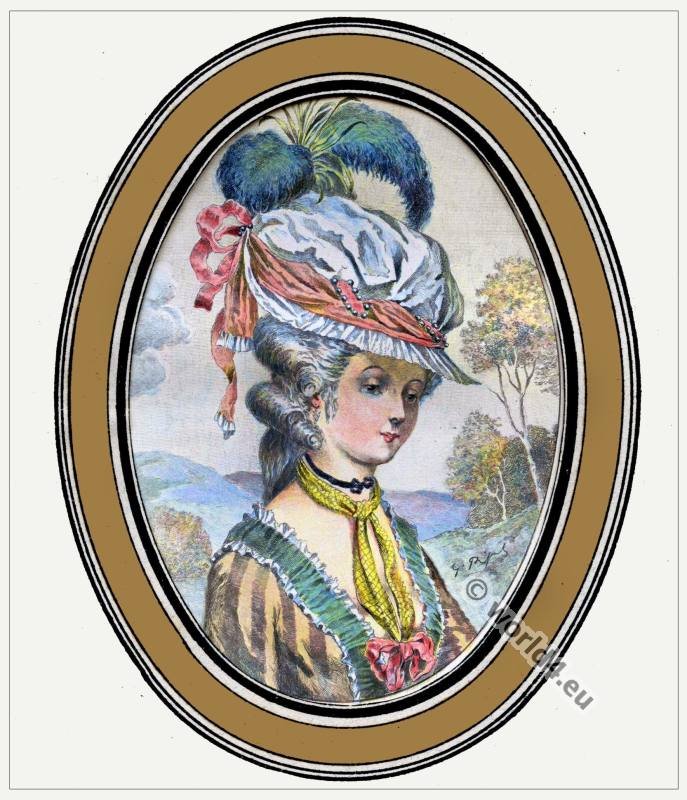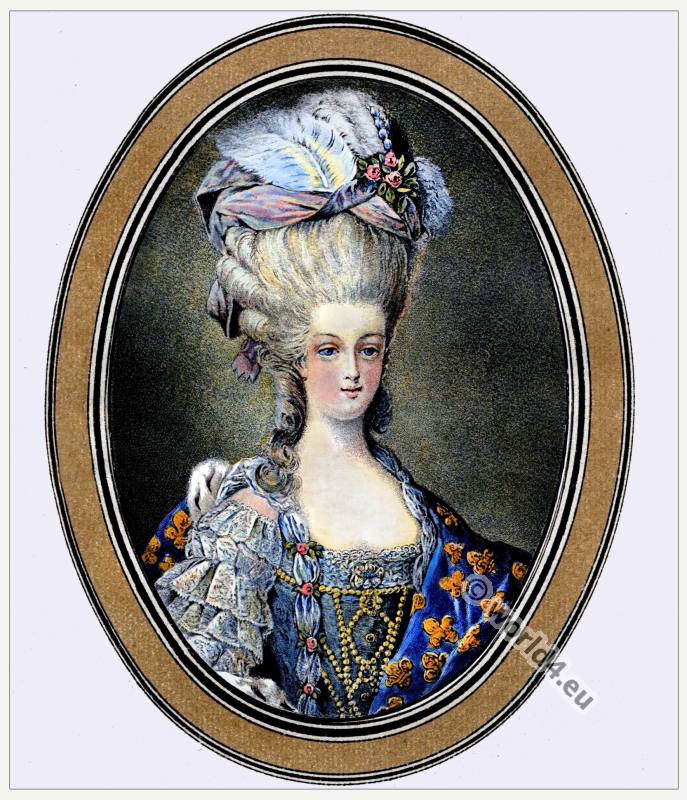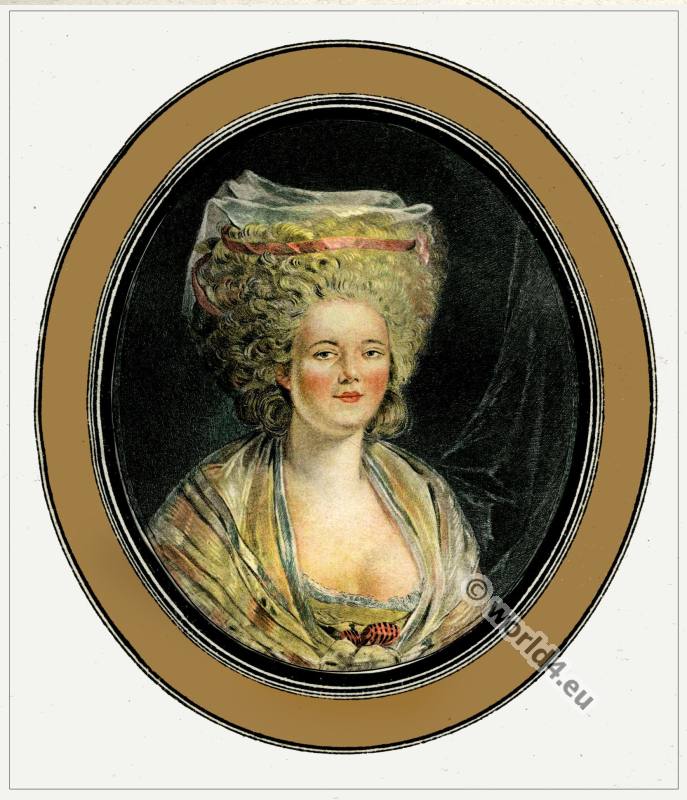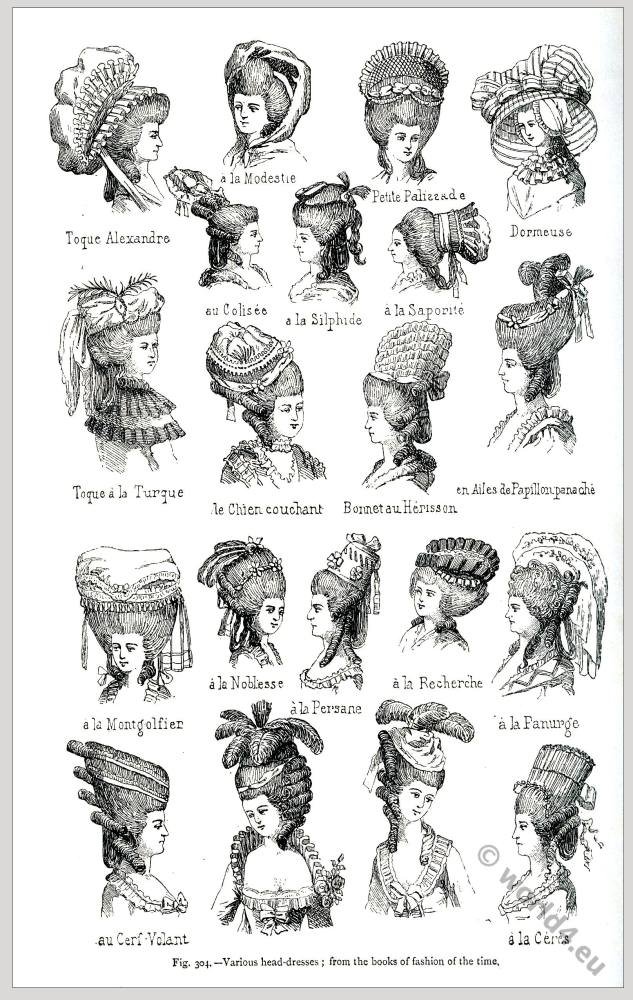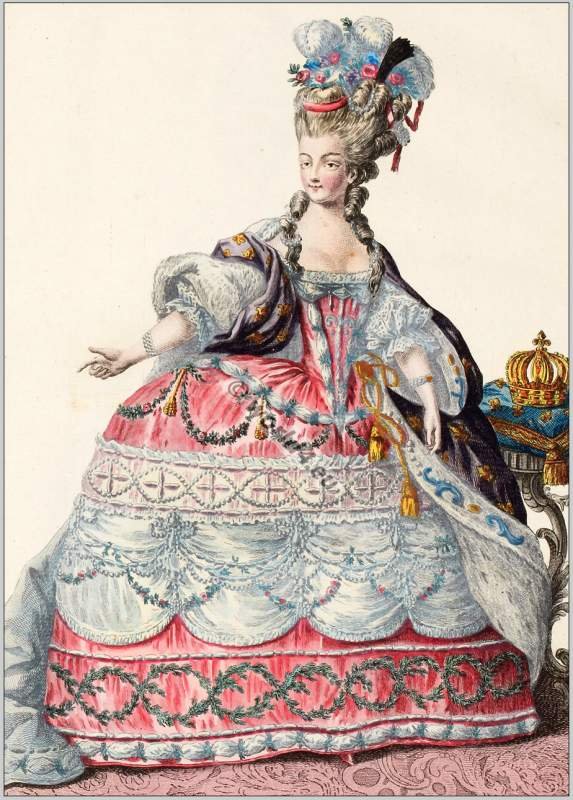Ladies hat styles from 1776-1790 by Rose Bertin.
„Il n’y a rien de nouveau dans ce monde que ce qui est oublié.“ There is nothing new in this world except what is forgotten. Rose Bertin
Excerpt from the book:
ROSE BERTIN THE CREATOR OF FASHION AT THE COURT OF MARIE ANTOINETTE.
CHAPTER I
THE BEGINNING OF A FAMOUS MILLINER – HER INFLUENCE AT COURT (1770-1774)
THE reign of Marie Antoinette was one of futility and chiffon; and if the Queen did not create the office of a Minister of Fashion, the Court of Versailles was nevertheless always crowded with hairdressers, dressmakers, and milliners, who exercised more influence than the King’s Councillors.
Rose Bertin was one of their number. Her real name was Marie-Jeanne Bertin, and thus she figures in all biographical dictionaries. She was born at Amiens in 1744, but recent researches, made in the archives of Abbeville, have fixed July 2, 1747, as the exact date of her birth. This is confirmed by an extract from her birth certificate inserted in the register of the parish of St. Gilles, and signed by the curate, Falconnier. Her parents were people of very small means, and the earnings of the father did not suffice to educate the two children, Marie-Jeanne and her brother, Jean-Laurent, two years younger than herself To augment the budget of the family, the mother was obliged to exercise the profession of sick-nurse.
Marie-Jeanne had thus received a very modest education, but sufficient to develop her sense of ambition. Nature had been kind to her; she was beautiful, and she knew it-women are never unconscious of such things, and are always ready to profit by it but Marie-Jeanne was also endowed with a great deal of intelligence, which enabled her to make her way in life.
She had faith in her star. One day a gipsy foretold her future. Rose was only a child when the gipsy was arrested and imprisoned. The cronies of the neighbourhood, talkative and superstitious, told wonderful things of the prisoner who had read the future in the palms of their hands. The child became curious, and longed to know what lay in store for her. But she had no money to pay the old woman for her prophecies, and neither father nor mother Bertin would ever consent to spend a trifle on such childish whims. Rose therefore starved herself, and carried her portion of food to the prisoner.
Prisons in those days were not what they are now, and the girl easily obtained access to the imprisoned gipsy, who, in exchange for a succulent dish, consented to lift the mysterious veil of the future. Taking the white hand of the child between her own long, dirty fingers, she said sententiously: “You will rise to great fortune, and will one day wear a Court dress.” Rose left the prison, her face beaming with joy.
But Nicholas Bertin, her father, who was seventy-two years old, died on January 24, 1754, leaving the burden of the family and the upbringing of the children to his widow. Rose loved her mother, and she was not a girl to allow the latter to work too much when she was in a position to come to her assistance. She was sixteen now, and one day she made up her mind to leave home, and mounted the coach which took her to Paris. Little did her people, who were sadly watching her departure, think that Rose was going to meet her fortune.
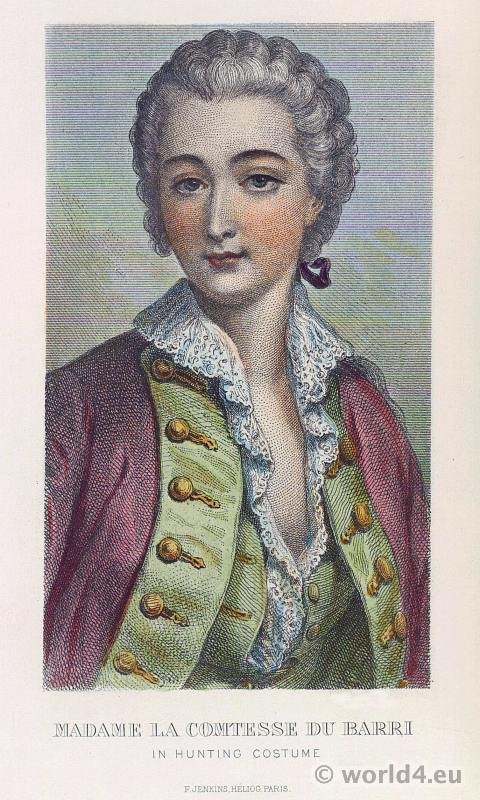
Rose Bertin was not awkward; they soon perceived it in the millinery shop kept by Mlle. Pagelle, under the name of the Trait Galant, where Rose had found a situation. And yet the Trait Galant which furnished not only the Court of France, but also that of Spain-enjoyed, as far as morals were concerned, a most respectable reputation, a fact of somewhat rare occurrence among the ladies of the millinery profession.
It was about that time, too, that Jeanne Bécu, who afterwards became the famous Mme. Du Barry, was apprenticed in the millinery shop of Labille, which was situated in the Rue Neuve-des-Petits-Champs, near the Place des Victoires. Jeanne Bécu, who was known at that time by the name of Mlle. Lanson, justified the reputation of the ladies of her profession, and had many lovers. Mlle. Oliva, who was afterwards to play her part in the famous affair of the necklace, was also a milliner, and was leading a life similar to that of Jeanne Bécu, Rose Bertin had been in the employ of Mlle. Pagelle for a short time, when an event occurred which was to decide her future.
Among the customers of the Trait Galant was Mme. de la Saune, formerly Mlle. Caron, and mistress of the Comte de Charolais, to whom she had borne two daughters. The Count having died, the Princesse de Conti obtained letters of legitimization for the two girls, who took the name of Mlles. de Bourbon. The elder soon married the Comte de Puget, whilst the younger became the wife of M. de Lowendal. The wedding dresses of the young ladies had been ordered at the Trait Galant, and the Princesse de Conti had asked to see the dresses herself.
It was about eight o’clock in the evening when Mlle. Pagelle despatched Rose to the Hôtel de Conti with the dresses of the Demoiselles de Bourbon. It was bitter cold, and when the milliner arrived at the palace, and asked to see the Princess, she was shown into a room where a huge fire was blazing. In a corner near the fireplace an old woman – whom Rose took for a chamber maid-was seated.
She got up as soon as the girl entered, exclaiming, “Ah, you have brought the dresses of the Demoiselles de Bourbon! let me see.” Rose satisfied her curiosity, and the two soon began to chat amicably, when they were interrupted by a Lady-in-Waiting. “What,” exclaimed the latter, “is your Highness here? ” “Yes,“ replied the Princess, “and I have been enjoying myself immensely.” Rose Bertin was quite embarrassed; she threw herself at the feet of Her Highness and begged for forgiveness. But the Princess told her that she had committed no breach of etiquette in having been natural, especially as she was ignorant of the identity of her interlocutress. She assured the milliner of her good-will and protection for the future.
This event is related in the “Mémoires de Mlle. Bertin” and published in 1824. These mémoires are now proved to have been written by J. Penchet with the purpose of whitewashing the memory of Marie Antoinette and exculpating her from certain accusations. It is, however, impossible that Penchet should have related certain anecdotes without having heard them from the people whom they concerned, and with whom he found himself in constant contact.
The Princesse de Conti had thus taken a decided fancy to Rose, and the latter soon received proofs of Her Highness’s kindness.

The Duc de Chartres was going to marry Louise-Marie-Adélaïde de Bourbon, daughter of the Duc de Penthièvre, and the richest heiress in the kingdom, and, thanks to the Princesse de Conti, Rose had received the order to make the trousseau for the bride.
Great was the pride of Rose Bertin when she announced the good news to her employer. Mlle. Pagelle, who had long ago ceased to consider Rose as a simple employee, opened her arms, and, embracing the little milliner, exclaimed: “Little one, from this moment you may consider yourself as my partner.” And henceforth the business of the Trait Galant had two heads, and the most turbulent partner, whose mind was constantly in search for new designs and models, was the little girl from Picardy, daring and ambitious, and who knew that she was going to make her fortune and a name famous in Europe.
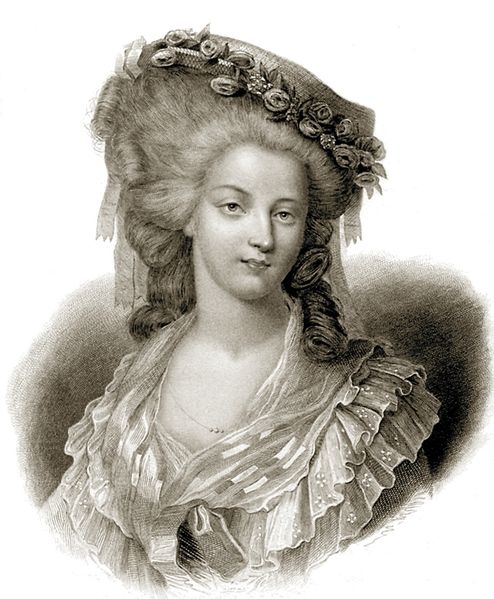
The Duchesse de Chartres also became a protectress of Rose, and she soon found a third in Mme. de Lamballe, But Rose was beautiful, elegant, and graceful. She had above all an air of distinction, and attracted a great deal of attention. One day the Due de Chartres noticed her in the apartments of his wife. She took his fancy. He spoke to her, and unhesitatingly made love to her. Would she become his mistress? He offered her diamonds, horses, a carriage, a fine furnished hotel, if she would only consent to listen to his impassioned declarations. But, to his utmost surprise, the little milliner would not listen to the proposals of the noble Duke.
The latter was nonplussed, and the more obstinate Rose was, the more desperate the lover grew. He at last decided to carry the girl off to a little house in Neuilly, where he hoped to make her yield to his wishes. Rose was informed of the plan by a valet of the Duke, and she lived in constant fear of being kidnapped and carried off to the secluded house at Neuilly. She scarcely ventured to leave her house at night. She knew too well the life led by the noblemen of her time, who modelled their conduct upon that of the King himself, and the abduction of a little milliner in those days would pass absolutely unnoticed. Every morning she went for her orders to the Duchesse de Chartres, and nothing had as yet happened, when one day she was called to the Comtesse d’Usson for an important order.
Rose was conversing with the Comtesse, when the Duke was announced, and Mme. d’Usson rushed to meet His Highness. Rose was evidently being forgotten, and, noticing an easy-chair, she calmly sat down. The Comtesse looked surprised, and motioned to the girl to get up. The milliner took no notice of her hostess, who at last exclaimed: “Mlle. Rose, you evidently seem to forget that you are in the presence of His Highness.” “Not at all, madame,” replied Rose; “I am not forgetting it at all.” “Then, why are you behaving as you do ?” “Ah!” answered the little milliner, “Mme. la Comtesse is evidently not aware of the fact that if I only wished it I could become Duchesse de Chartres tonight.”
The Duke changed color, but said nothing, whilst the Comtesse looked surprised, with the air of someone who is waiting for the solution of a riddle.
“Yes, madame,” continued Rose, “I have been offered everything that can tempt a poor girl, and because I have refused I am now in danger of being kidnapped. If, therefore, one day your bonnets and dresses are not ready, and you are told that little Rose has disappeared, you will have to address yourself to His Highness, who will know of her whereabouts.”
“What do you say to this, monseigneur?” asked the Comtesse d’Usson.
“What can I say?” replied the latter. “All means are fair when it is a question of subduing a rebel, and I can surely not be blamed for having tried to obtain the favour of such an amiable and beautiful young lady.”
“Monseigneur is perfectly right to prefer a little milliner to his august wife the Princess, who posesses the highest qualities; but you will admit, madame; that I too may be allowed to treat familiarly one who is so anxious to make me his companion. If His Highness will only not forget his rank, I will certainly remember the extreme distance which separates us.” Thus spoke Rose, and making a low bow to the Duke, who was murmuring, “You are a little viper,” she left the room, leaving His Highness much perplexed. Henceforth, however, he ceased worrying the milliner with his assiduities.
Rose Bertin did not remain very long in partnership with Mlle. Pagelle. She soon established her own business, thanks to the help she had received from the Duchesse de Chartres. The latter was in the habit of thus helping poor girls and setting them up in business. Rose Bertin often met the protégées of the Duchess in the antechamber of the ducal palace. One of these protégées was Marie the flower-girl, whom the Duchess had once met in the street and taken a fancy to.
Not only had the Duchess provided the funds for Rose’s business, but she also recommended her to a fashionable clientèle. At that moment the talk of Court and town was the approaching marriage of the Dauphin with the daughter of Empress Maria Theresa. In March, 1770, the Duchesse de Chartres went to see Mme. de Noailles, who had been appointed Lady-in-Waiting to the Dauphine, and Mme. de Misery, chosen to be First Chambermaid. She spoke highly of her protégée, praising not only her talents, but also her manners, and, supported by the Princesses de Conti and Lamballe, she procured for Rose the advantage of furnishing the dresses and finery which were to be offered to Marie Antoinette at Strasburg on her arrival on French soil.
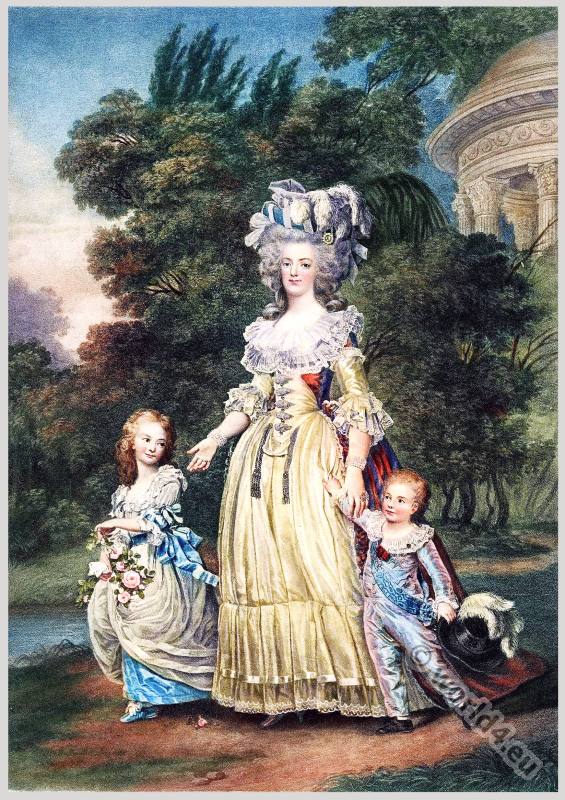
Milliners in the eighteenth century were not what they are nowadays; they not only trimmed hats, but also arranged and ornamented dresses. There were a good many milliners in Paris in those days, and some of them exercised their trade on the Quai de Gèvres, where Rose Bertin is supposed to have kept a shop for some time. In any case, she remained there only a short time, and soon we find her established in the Rue de St. Honoré, which was the centre of commerce during the reign of Louis XVI. The signboard of her business contained the inscription “Au Grand Mogul.”
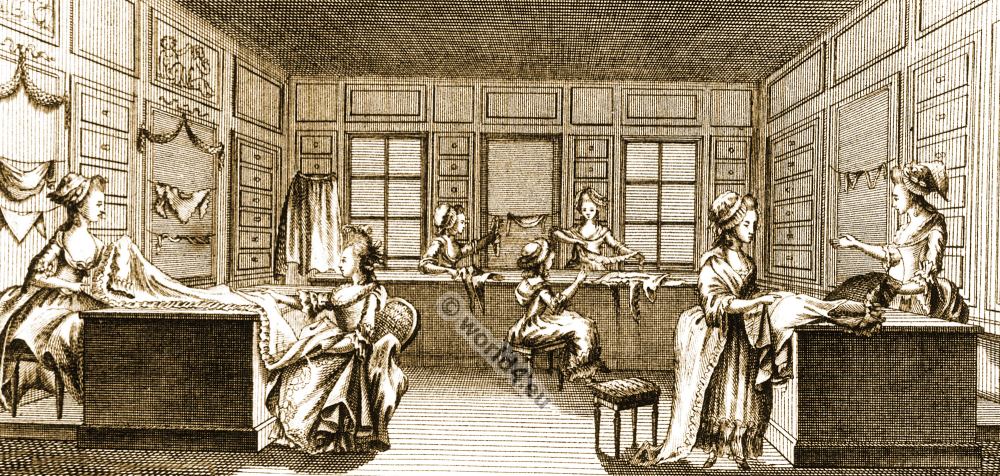
The houses in those days were not numbered, and the signboards were therefore very important, especially as far as the merchants were concerned. Each had his signboard with an inscription so as to avoid confusion. Thus one could read in the Rue de St. Honoré, “Au Trait Galant,” “Au Grand Mogol,” “Au Bouquet Galant,” ” A la Corbeille Galante,” and many others.
The reputation of Rose Bertin grew rapidly, and soon reached her native town. Among her customers she counted several inhabitants of Abbeville, a fact which was testified by her books of account.
In the meantime the new Dauphine, very fond of chiffon and ribbons and of all feminine finery, was going to introduce-or at least to augment at the Court of Versailles the cult of fashion, which is often nothing but an insupportable slavery. When Rose Bertin had the honour of approaching Marie-Antoinette for the first time, she at once knew, thanks to her flair as a business woman and her subtlety as a native of Picardy, what benefit she could derive from her situation. She had only to flatter the Dauphine, which was not so very difficult, and by pleasing the latter vastly increase her own income.
According to the “Souvenirs” of Léonard, Rose Bertin is supposed to have been introduced to the Dauphine in 1772. The author of these “Souvenirs” is unknown, and the authenticity of the work has been contested; but it is one of the few writings which make allusion to Mlle. Bertin. This so-called Léonard not only pretends that he was the first to introduce Rose to Marie Antoinette, but he even boasts of his intimate relations with the beautiful milliner. We shall quote the following passage from these “Souvenirs”: “One morning I was informed by my servant that a young lady wished to see me. I soon found myself in the presence of a young, beautiful, and very elegant person, whose manners were charming.
Her manner was at first somewhat reserved. I at once thought that the charming person had come to solicit my influence at Court in her own favor or in favor of some relation. And, indeed, I was not mistaken. I made the young lady sit down near the fireplace, and I at once noticed that she often availed herself of the opportunity to show her beautifully-shaped foot; and a beautifully-shaped ankle always makes a man disposed to listen favorably to a woman.”
” You will not be surprised at my visit, M. Léonard, said this seductive person, if i tell you who i am. My name is Rose Bertin. The Princesse de Conti and the Duchesse de Chartres have kindly promised to introduce me to Her Royal Highness the Dauphine; but you know what these great ladies are one must never press them. I have therefore come to you, M. Léonard, whose constant attendance upon Her Highness will give you ample opportunities to speak on my behalf. And you are constantly being consulted upon everything relating to dress-your recommendation will no doubt have a decisive effect.”
M. Léonard promised his help. And, indeed, he kept his word, and at the very first opportunity he mentioned the name of Rose Bertin to the Dauphine.
” Mlle. Rose Bertin!” said Marie Antoinette. ” You are right to mention her to me, for I now remember that the Duchesse de Chartres and the Princesse de Conti have also spoken of her in very high terms. Comtesse de Misery,” continued the Dauphine, turning to her first Lady-in-Waiting, “will you please write to Mlle. Rose Bertin, and command her presence here tomorrow.”

Rose Bertin became Court milliner in 1772.
Rose Bertin was punctual, and introduced to Marie Antoinette according to all the rules of Court etiquette. Marie Antoinette gave the young milliner an order of 20,000 livres. Thus, according to the author of the “Souvenirs,” Rose Bertin became Court milliner of the Dauphine in 1772. The dates are in all probability exact, but the details of the introduction and presentation of Rose Bertin to Marie Antoinette as given by Léonard are pure invention. Léonard Antié, who enjoyed a considerable reputation, did not live in the Palace of Versailles, as the “Souvenirs” pretend. He was the hairdresser of Marie-Antoinette, but was in daily attendance upon her. His services were only required on gala-days and special occasions.
The daily coiffeur of the Dauphine was Leonard’s brother, who was beheaded during the Terror, and consequently could not have written the ” Souvenirs,” which were compiled at a much later period. Other dates tend to prove that the whole story of Rose’s introduction to the Dauphine by Léonard, who at that moment had absolutely no influence at the Court of Versailles, he having been appointed only in 1779, is devoid of all truth. These ” Souvenirs “ contain numerous anecdotes and insinuations and allusions to the part played by Marie Antoinette in various affairs.
Rose Bertin is often mixed up with these affairs as, for instance, that of the masked ball, where, at the suggestion of the Comte d’ Artois, the Dauphine was present. According to the author of the ” Souvenirs,” Léonard was ordered to arrange this nocturnal expedition and to provide the costumes. “I want to go to a masked ball,” said Marie Antoinette; “Léonard will help us. He will arrange with Mlle. Bertin about the costume, and we will dress at the Tuileries. We will leave here at midnight accompanied by the little Marquise de Langeac, and be at the Tuileries at twelve thirty-five. Rose Bertin will be waiting for us at the PavilIon de Flore; at one thirty we shall be at the ball, and leave at three o’clock; and before the clocks strike four we shall be asleep in our beds at Versailles.” “I arranged the costume of the Dauphine,” adds the so-called Léonard, “together with Mlle. Rose Bertin. The Dauphine went disguised as a Swiss peasant woman.
When the costume was finished and the disguise, we left in two carriages – the Dauphine, the Prince, and the Marquise, in one, and Léonard and Rose in another. I do not know whether during our ride from the Tuileries to the house of Dauberval Mme. de Langeac had noticed what degree of intimacy existed between Mlle. Rose and myself, but when we arrived the malicious little gipsy (the Comtesse was disguised as such) pinched me cruelly, and whispered into my ear: “I like the intrigues of a masked ball very much, but never in the capacity of a passive spectator. “
There is no doubt a great deal of fatuity in all that the author of the “Souvenirs” relates; but the enemies of Marie Antoinette did not hesitate afterwards to make use of them, and in their pamphlets introduced, without distinction of rank or sex, all those who were constantly in the entourage of the Queen, so as to give a greater semblance of truth to their accusations.
Indeed, Rose Bertin did not require the recommendations of Léonard to get on at Court. Were not the Duchesse de Chartres and the Princesse de Conti her patronesses? And in 1773 the little milliner made use of her influence on her relatives who had been imprisoned in the Bastille.
The relatives of Rose were booksellers established in the Rue de la Juiverie. In March, 1772, a perquisition had already been made in the shop in consequence of the publication of certain pamphlets directed against the “Parlements,” and especially of a satirical work in which the Chancellor Maupeou (René-Nicolas-Charles-Augustin de Maupeou 1714-1792) was being attacked and criticized. And now the widow Méquignon, a relative of Rose’s, was arrested on June 19, 1772, “and at once led away to be confined in the Bastille?” (Journal de Hardy,” MS. 6681, in the Bibliotheque Nationale.)
Rose made use of her influence at Court, and did her best to deliver the widow Méquignon and her son. She spared neither time nor trouble, and at last succeeded in interesting the Dauphine herself in the matter. On September 4, 1773, the two prisoners left the Bastille. Their freedom had been obtained not without some difficulty, for Marie Antoinette had to do with Maupeou, who as a rule did not like to relinquish the prey he had got hold of. The widow Méquignon, although set free, was, however, not discharged, but sentenced, on January 22, 1774, to be exiled for five years from Paris. But Rose Bertin was tenacious, and therefore her protectresses, above all the Dauphine, opposed the Chancellor’s decision.
The “Journal de Hardy” gives some details with regard to this affair, adding that, thanks to the insistence of Rose Bertin, the Dauphine at last made Maupeou revoke the sentence against the widow Méquignon on February 21, 1774. Marie Antoinette even expressed the wish to see that widow Méquignon on whose behalf she had so graciously intervened. On February 24, therefore, the lady had the honor of dining with the Dauphine, “who expressed her great satisfaction at having rendered such service to the respectable widow, and thus saved her and her family from the consequences of a severe sentence.”
This opinion on the character of the widow, expressed by her colleague the bookseller Hardy, whose veracity is above suspicion, only tends to justify the steps taken by the milliner and the initiative of Marie Antoinette. Maupeou and the Archbishop of Paris were both annoyed at the turn the matter had taken, and only reluctantly disarmed. Some time afterwards, therefore, the Archbishop of Paris, who never missed an opportunity of showing his antagonism towards the Jansenists, no matter to what sex or condition they belonged, accused the widow Méquignon of Jansenists. The magistrates, however, found it impossible to justify the accusations of the prelate.
Thus ended this matter, the result of which was a triumph of Rose Bertin. But the widow Méquignon also derived considerable benefit from her temporary arrest, for she remained Court bookseller until the Revolution, and it was from her that Mme. de Tourzel bought the books required for the royal Princes, as is testified by the accounts of 1790-1792, kept at the Archives Nationales.
During all this time the workshops of Rose Bertin were producing bonnets à la Chartres – a creation expressing Rose’s gratitude for her benefactress – bonnets à la Sultane, au Trésor royal, à la Carmélite, and were trimming dresses à la Musulmane. The prices of the bonnets a la Chartres varied from 7 to 14 livres, whilst the others amounted to about 30 livres. The trimmings of a robe à la Musulmane cost 136 livres. Ever since Rose had been appointed to furnish the bonnets and dresses of Marie Antoinette her reputation had been rapidly increasing, and she had been obliged to augment the number of her employées. But her real importance only dates from May, 1774, when Louis XVI. succeeded Louis XV.
The first thing Rose did was to change the inscription on her signboard, and replace her Christian name by that of her family. At Court she was still known as Mlle. Rose, but in town her dignity of Milliner of the Queen required it that she should call herself Mlle. Bertin. Her success was great. The best families of the aristocracy were among her customers, such as the Marquise de Bouillé, the Comtesse de Duras, the Duchesse de la Vauguyon, the Princesse de Guéméné, etc.
The budget of the dress department of the Dauphine amounted in 1773 to 120,000 livres, and the expenses were regulated by the Duchesse de Cossé: 32,000 were spent on ordinary dresses, whilst 82,000 covered the extraordinary expenses. In 1774 the figures were the same, but they were soon to increase.
The winter of 1774 was approaching its end, when a new fashion of hairdress made its appearance, and was baptized the Quès aco. “It consisted of a panache in plumes, which the elegant ladies wore at the back of their heads.” The name Quès aco is supposed to have been taken from a mémoire by Beaumarchais, directed against a certain Marin, whom the author had ridiculized. The mémoire of Beaumarchais had an enormous success, and the expression of Quès aco became very popular.
Marie Antoinette had taken art interest in this event, the name of Beaumarchais being mentioned at Court very often, and she had asked for an explanation of the Provençal expression. When she understood it, she frequently happened to make use of it. Among her intimates, Rose Bertin, who was always au courant of big and little events, always in search of new ideas and new creations, and names by which to baptize the latter, was quick enough to make use of the incident, and soon imagined a new hairdress known as the Qués aco. Generally speaking, everything relating to fashion is of ephemeral character, but the headgears of those days were prodigiously so.
A month after the introduction of the Qués aco a new invention took its place; it was the famous pauf aux sentiments. “The pouf aux sentiments,” writes the continuator of Bachaumont on April 26, 1774, ” is a new hairdress which has succeeded the Qués aco, and is infinitely superior to the former, on account of the numerous things which were required for its composition, and the genius employed to vary it artistically. It is called pouf on account of the numerous objects which it can contain, and aux sentiments because these objects must have a certain relation to what one loves best, and express one’s preferences. Every woman is madly anxios to have a pouf.”
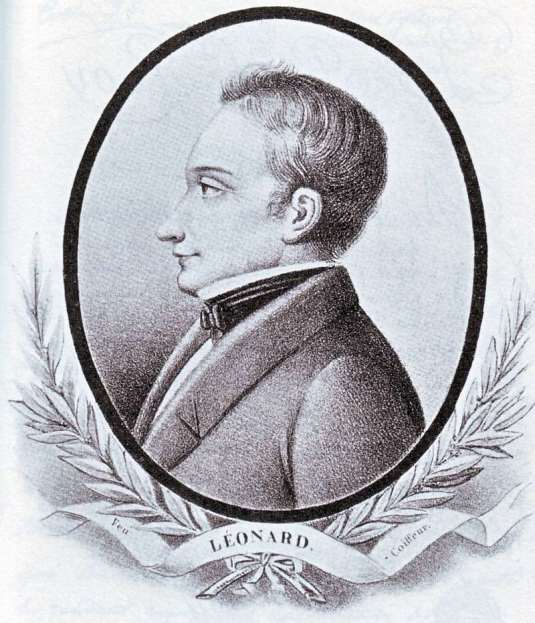
Léonard Antié hairdresser of Marie Antoinette.
Léonard Antié is supposed to have excelled in the art of placing pouts of gauze, which were introduced between the locks, and one day he employed for that purpose about 14 yards of gauze for one hairdress. But all these poufs differed greatly from the pouf aux sentiments owing to their simplicity; they also required no assistance from the milliner. The pouf aux sentiments could contain such various objects as fruit, flowers, vegetables, stuffed birds, dolls, and many other things giving expression to the tastes, the preferences, and the sentiments, of the wearer.
The continuator of the mémoires of Bachaumont has left us a description of a pouf aux sentiments worn by the Duchesse de Chartres: “In the background was the image of a woman carrying an infant in arms; it referred to the Duc de Valois and his nurse. To the right was a parrot picking a cherry; the parrot was the Duchess’s pet bird. To the left was a little black man – the image of him whom she loved very much. All this was ornamented with locks from the hair of the Duc de Chartres, the husband, the Duc de Penthièvre, the father, and the Duc d’Orleans, the father-in-law, of the lady.”
This craze in hairdress, with its accumulation of family relics and souvenirs, may have been touching, but strikes one as rather ridiculous, more ridiculous than the landscapes in hair which enjoyed a certain vogue during the first half of the nineteenth century, and in the composition of which Frédéric Sauvage greatly excelled.
Another famous pouf was that of the Duchesse de Lauzun. The Duchesse one day appeared at a reception of the Marquise du Deffant’s wearing a most delicious pouf. It contained a stormy sea, ducks swimming near the shore, someone on the point of shooting one of them; on the top of the head there was a mill, the miller’s wife being made love to by an abbé, whilst near the ear the miller could be seen leading a donkey.
It was also in consequence of one of these poufs that a stormy scene took place one day between Mlle. Rose Bertin and the famous Mlle. Quinault, who occupied an apartment in the Louvre, just underneath that of Sedaine, and where she had received the most distinguished people of the century.
Everybody was talking of the poufs created by the firm of Bertin, and Mlle. Quinault also wished to have one made in the famous workshop. She therefore simply sent her maid for Mlle. Bertin. The latter, however, took no notice of the message. Then Mlle. Duport, chambermaid and favourite of Mlle. Quinault, came in her mistress’s carriage, and asked Mlle. Rose how she dared to disobey the order she had received. The milliner lost her temper, and a quarrel ensued. The chambermaid was surprised at the insolence of an ordinary milliner, to which Rose replied that a milliner who had the honor of being employed by Her Majesty the Queen was, anyhow, as good as a former opera actress. This was too much for the chambermaid. Mlle. Quinault was married to the Duc de Nevers, and the working woman had dared to insult a member of the highest aristocracy.
Several ladies secretly married to noblemen of the highest rank saw themselves offended in the person of the Duchess, and all unanimously demanded the punishment of Mlle. Bertin. The latter at first fought bravely against her enemies; was she not sure of the friendship and affection of the Queen? But the excitement caused by the incident was so great that Marie Antoinette herself advised Rose to humiliate herself and to ask Mlle. Quinault’s forgiveness.
The Queen’s wish was law to Rose. She went straight to the Louvre, and to the apartments of Mlle. Quinault, where she asked for Mme. Duport. “And what does the Bertin woman want?” asked the latter. The Bertin woman! To be called “the Bertin woman” by a chambermaid was a terrible insult, when ladies of the aristocracy addressed her as Mademoiselle, and often even as Madame. But Rose kept her temper, and simply asked to see Mlle. Quinault. “Mademoiselle is unwell, and will not be able to see her milliner,” was the reply; “but we will inquire.”
Rose was kept waiting for nearly an hour, and at last was admitted into the presence of the former actress. Mlle. Quinault at first took no notice whatever of Rose Bertin, and when the latter began to offer her excuses the offended Queen of the Stage listened calmly, without even raising her head. When Mlle. Bertin had finished, the offended Mlle. Quinault replied: “My good woman, a creature of your position ought to learn to be polite to her betters, and to obey the orders of those who pay her- you may go!”
These words are characteristic of the eighteenth century. It is astonishing that, with her character, her sense of independence, and her pride, Rose should have remained faithful to the past when the Revolution broke out. But she was very devoted to the Queen, and it was this devotion which prevented her from becoming an enemy of the Monarchy.
She left the apartment of Mlle. Quinault in such a state of rage that she was ill for more than six weeks. For more than a fortnight Paris talked of nothing but the incident of Quinault-Bertin, and ever afterwards Mlle. Bertin was exceedingly polite to all her customers. The death of the King put an end to the pouf auox sentiments.
“The mourning for the King,” writes the Baroness d’Oberkirch in her memoirs, “put an end to a very ridiculous fashion which usurped the place of the Quès aco. This was the pouf aux sentiments. It was a head-dress into which may be introduced the likeness of any person or thing for which one may feel affection, such as a miniature of one’s daughter or mother, a picture of a canary or a dog, etc., adorned with the hair of a father or of a beloved friend. It was a most incredible piece of extravagance. We were determined to follow the fashion, and the Princess Dorothea once amused herself for an entire day by wearing on her ear the picture of a woman holding a bunch of keys, and which, she declared, was Mme. Hendel. The femme de charge thought it a striking likeness, and was almost out of her senses with pride and joy.” This Mme. Hendel was femme de charge of Princess Dorothea at the Castle of Montbéliard.
Thus, according to Mme. d’Oberkirch, who was herself one of Mlle. Bertin’s customers, the fashion of the pouf was extremely ridiculous, and only suitable for a carnival. And yet, by some inexplicable aberration of good taste, this predilection for the ridiculous, as far as fashions are concerned, may be noticed at various epochs, and we have only to mention the crinoline, which hid the beautiful lines of the female body.
But there were still sensible women whom the eccentricities of fashion did not affect. And the Marquise de Créqui, who, as it appears, had never been one of Rose’s customers, makes fun of the importance attached by the ladies to a new hat or a new hairdress. “Neither Cæsar nor Epaminondas,” writes the Marquise, “have spent so much thought upon the arrangement of their armies or the event of a battle, as is being spent by my contemporaries upon a pouf, or a well-adjusted ribbon, or a bouquet. Too much consideration is given to the inventors of fashion, whilst real merit is being neglected. We must be like the others, and avoid appearing peculiar and singular – this I admit. But we may at the same time try to be neat in our simplicity, noble in our tastes, and modest in our fashions. For fashion is a tyrant under whose rule only fools consent to bend.”
Literature:
- The Eighteenth Century Woman by Olivier Bernier. The hallmarks of the eighteenth century – its opulence, charm, wit, intelligence – are embodied in the age’s remarkable women
- Souvenirs of Léonard: Hairdresser to Queen Marie-Antoinette (1897)
- “Rose Bertin” by Émile Langlade in the English translation by Dr. Angelo S. Rappoport (1913).
- La marchande de modes de Marie-Antoinette: Rose Bertin by Langlade, Émile
- Un ministre des modes sous Louis XVI: Mademoiselle Bertin, marchande de modes de la reine, 1747-1813 – Nouvion, Pierre de
- Mémoires de Mademoiselle Bertin sur la reine Marie-Antoinette, avec des notes et des éclaircissement – Peuchet, Jacques, 1758-1830
- Rose Bertin couturière de Marie-Antoinette.
Source: PIERRE DE NOUVION et ÉMILE LIEZ. UN MINISTRE DES MODES SOUS LOUIS XVI MADEMOISELLE BERTIN MARCHANDE DE MODES DE LA REINE 1747 – 1813. ILLUSTRATIONS GRAVEES EN COULEURS PAR G. RIPART. A PARIS CHEZ HENRI LECLERC 219, RUE SAINT-HONORÉ, 219. MDCCCCXI.
Un Ministre des Modes sous Louis XVI, Mademoiselle Bertin. Marchande de Modes de la Reine, 1743-1813. By Pierre de Nouvion amd Emile Liez, illustrated by G. Ripart. Published by Henri Leclerc, Paris.

